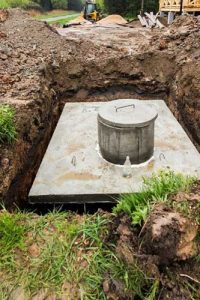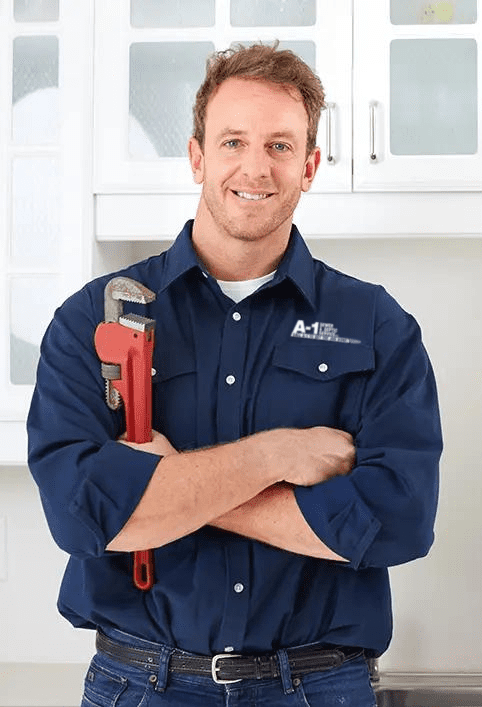Do you know how to maintain your septic system? With septic tank repairs & replacement starting in the $1,000’s, it’s important to keep your septic system in the best possible condition. Fortunately, it’s not hard to take care of it, if you follow a few simple tips.
First, though, let’s quickly review the basics of a septic system. Two parts comprise a septic system: the tank and the drain field. The septic tank is an underground container responsible for holding solids and scum that comes from your household wastewater. With the proper maintenance, it should last thirty years or so. Once in the septic tank, heavy solids sink to the bottom, and bacteria reduce them to sludge and gasses (this is the sludge layer). Grease and other lighter solids rise to the top to form a scum layer (maintaining proper scum levels is part of a well-running system); solid waste that doesn’t decompose must be periodically removed by pumping. Effluent, the wastewater that leaves the septic tank, enters the drain field for its final treatment and disposal. The drain field is made up of a network of perforated pipes in gravel trenches buried beneath the soil. The drain field can flood if it’s too full of wastewater or outside liquid, and that can lead to a sewage backup. The goal, therefore, of maintaining the septic tank, is to prevent solids from accumulating and avoid groundwater contamination.
- Have your system regularly serviced. How often do you need your septic system pumped? It depends on the size of your household, water usage (the total wastewater generated, the number of solids, and the size of your tank. The official EPA (Environmental Protection Agency) recommendation is that you have the system pumped every three years, but it’s a good idea to have it inspected and serviced more often than that (especially with heavy water use). Keeping onsite wastewater treatment maintenance records can help keep you on a schedule.
- Mind what goes down the drain and kitchen sink. Perhaps the most important thing you can do for your septic system is to be careful about what goes into it. Water from your shower, hot tub, garbage disposal, sinks, washing machine, and toilet all go down to the septic tank. Therefore, it’s crucial to watch what you flush or pour down the drain, for both preventing buildup and clogs, but also keeping the ecosystem of the tank in balance. Be careful not to introduce any of the following into the drainage system:
- Fats or grease
- Chemicals or drain openers
- Motor oils or fuels
- Disposable diapers
- Dental floss
- Coffee grounds, eggshells, or nutshells
- Filter tip cigarettes/cigarette butts
- Sanitary napkins, tampons (or other feminine hygiene products) or condoms
- Paper towels or rags
- Certain soaps and cleaning products that have harmful chemicals
- Excessive toilet paper
- Paints, household chemicals, certain detergents and drain cleaners
Avoiding these items is a great way to keep your septic system working well, and is part of a good onsite septic system maintenance plan. This can also help avoid bad odors and smells.
- Use an additive. Bacteria additives are made up of live, organic bacteria that break down the solids and substances that enter your septic system. Using these additives replaces natural bacteria that’s been killed, and is an inexpensive way to keep the system functioning policy.
- Maintain the drain field (leach field). This means preventing traffic, whether it’s heavy equipment, livestock, or vehicles. You’ll also want to be careful about what you plant, and avoid planting trees nearby so that you don’t end up with roots in your septic system (whether you plant trees or other large plants, it’s the large roots that can cause a system failure if they break through into your septic tank system). Avoid having your roof drains, sump pumps, HVAC drains, or other excess water that may cause an issue.
- Conserve water. When you waste water, it all goes into the septic tank. That’s why it’s a good idea to save water whenever you can. Water-saving showerheads, washing machines that can do full loads using fewer gallons of water. Adopting habits that use less water is a great way to reduce water usage without having to purchase items to reduce water use. This excess water issue is why an extremely heavy rain storm can affect your system.
- Know the signs of a problem. If your septic system is giving off an unpleasant odor, or there’s surfacing sewage, of course, you’ll recognize that as a problem. However, lush vegetation in the drain field area and wet spots in your lawn are also signs of an overloaded septic system. IF there are gurgling sounds in the plumbing, the fixtures drain slowly, or the plumbing backs up, call for service right away.
- Hire the right service provider. Shop around for service providers, and don’t just hire the cheapest. Instead, make sure you hire a provider with the necessary experience and know-how to get the job done correctly.
Septic Tank 101
Septic tanks are a mystery to most people, a few of us think about where our wastewater goes once it’s down the drain. For homeowners considering a septic system, or who currently have a septic system, there are a few questions plumbing contractors frequently answer regarding septic tanks.
What is a septic tank? A septic tank is an on-site sewage treatment and disposal system that’s buried in the ground. They’re typically found in rural areas where a connection to sewer systems is not available. Septic tanks take wastewater and separate solid matter from it, which settles at the bottom of the septic tank. Water is returned to the soil around the septic tank. Over time, these systems can become full or develop problems that result in polluted water escaping into the environment or sewage backing up into the house, making septic tank maintenance important.
- How long do septic tanks last? If properly maintained, septic tanks can last between 25 and 35 years.
- How often should I have my septic system pumped? In general, you should have your tank pumped every three to five years to ensure optimum function.
- Is it okay to plant a vegetable garden or shrubs over the area where the septic tank is buried? No. you do not want anything other than grass or dirt within 30 feet of where the septic tank is buried. Tree roots can clog soil pipes. If you water a vegetable garden or shrubs planted over a drain field, it can result in excess water in the soil, which compromises its ability to treat wastewater.
- How can I tell if my septic system is failing or needs to be pumped? Some signs of a failing or full septic system include sinks and toilets backing up, slow draining toilets and drains, a wet area near where the tank is buried, or an odor of sewage in the house.
A-1 Sewer & Septic Service is a 24-hour plumbing contractor serving Kansas City, MO; Kansas City, KS; and Johnson County. With years of experience and well-trained staff, A-1 Sewer & Septic Service can handle any septic tank or plumbing-related job, large or small.




